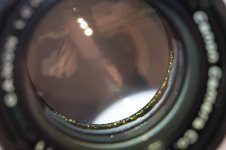csmithstack
Newbie
Hi! New member here, just getting started in the world of adapting old rangefinder lenses to my digital x-pro 2. ... might be a gateway to film?
Anyhow, I just received my first old lens from e-bay--a type III (I think) Canon 50mm f/1.8. The seller (in Japan) seemed knowledgable enough and trustworthy. It was described as having "no balsam separation," but upon receipt of the item, I looked through the front element in regular daylight (no flashlight necessary, and saw a sort of refractive sparkle around the entire perimeter of one of the middle elements (behind the aperture, I believe). I've done what I can to take a representative image of what I'm seeing, but I've got a baby strapped to my chest, so couldn't quite attain perfection! 😱 I think it reflects what I'm seeing pretty clearly, though...
Does this seem like balsam separation to anyone here? Or something else worthy of note? The lens has clearly been CLA's in the past, so maybe it has something to do with that... I've looked around the net for images and examples and nothing seemed to match what I'm seeing here.
I paid about $200 for this, so don't expect perfection, but would have preferred one of the examples with haze or fungus and _no_ separation for a similar price--those seem easier for me to deal with on my own.
Thank you for your thoughts! I'm finding this forum to be a great resource.
Anyhow, I just received my first old lens from e-bay--a type III (I think) Canon 50mm f/1.8. The seller (in Japan) seemed knowledgable enough and trustworthy. It was described as having "no balsam separation," but upon receipt of the item, I looked through the front element in regular daylight (no flashlight necessary, and saw a sort of refractive sparkle around the entire perimeter of one of the middle elements (behind the aperture, I believe). I've done what I can to take a representative image of what I'm seeing, but I've got a baby strapped to my chest, so couldn't quite attain perfection! 😱 I think it reflects what I'm seeing pretty clearly, though...
Does this seem like balsam separation to anyone here? Or something else worthy of note? The lens has clearly been CLA's in the past, so maybe it has something to do with that... I've looked around the net for images and examples and nothing seemed to match what I'm seeing here.
I paid about $200 for this, so don't expect perfection, but would have preferred one of the examples with haze or fungus and _no_ separation for a similar price--those seem easier for me to deal with on my own.
Thank you for your thoughts! I'm finding this forum to be a great resource.


